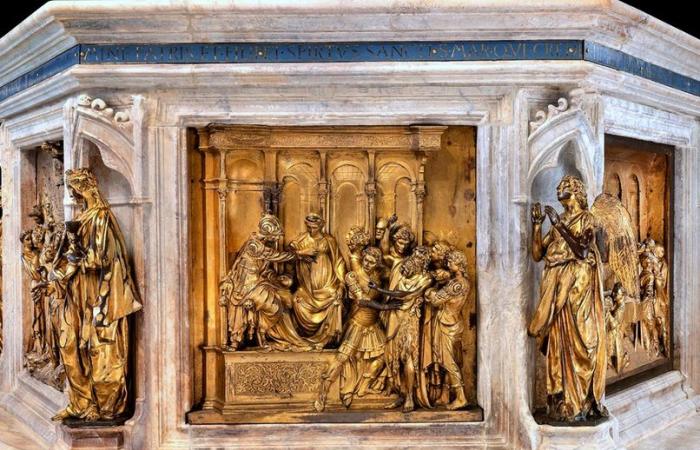by Redazione, published on 25/06/2024
Categories: News / Disclaimer
After the restoration conducted by the Opera della Metropolitana di Siena and the Opificio delle Pietre Dure, the Baptismal Font, a Renaissance masterpiece created by Donatello, Jacopo della Quercia, Ghiberti and Giovanni di Turino, once again shines.
TheMetro Opera Of Siena and theArchdiocese of Siena, Colle di Val d’Elsa and Montalcino concludes the restoration of the Baptismal Font in Siena Cathedral by returning it to visitors. The sculptural work created by Donatello, Jacob of the Oak, Ghiberti and John of Turino, will be visible again starting June 25 after three years of conservation work of the highest and most innovative technical level, conducted by the Opera and the Opificio delle Pietre Dure, led first by Marco Ciatti and, later, by Emanuela Daffra. Under the high supervision of the Superintendency of Archaeology, Fine Arts and Landscape for the provinces of Siena, Grosseto and Arezzo, first directed by Andrea Muzzi and, currently, by Gabriele Nannettithe staff of the Opera and the Opificio, with the collaboration of restorers and university professors, advised the restoration project, returning to the Church, the City and the world a masterpiece of immeasurable beauty. The intervention, financed by the Opera della Metropolitana di Siena, is the result of a synergy between the Fabbriceria, the Superintendence of Archaeology, Fine Arts and Landscape for the provinces of Siena, Grosseto and Arezzo and the Opificio delle Pietre Dure di Firenze (OPD), which was entrusted with the direction of the restoration, coordinated by art historians Laura Speranza and Riccardo Gennaioli, directors of the OPD’s Bronzes and Stone Materials Restoration sectors. Restorer Andrea Galganiand Restoration Collaborators Serena Bianchi and Lucrezia Coletta together with external restorer Irene Giovacchinicarried out consolidation and cleaning interventions following the indications and methodological choices elaborated by the technical and scientific direction of the restoration entrusted to the Restoration of Stone Materials sector of the OPD with restorer Camilla Manciniactive in the first person, and of Riccardo Gennaiolidirector of the sector.
In OPD’s laboratories in Florence, internal restorers Maria Baruffetti, Annalena Brini, and Elisa Pucci of the Bronzes sector directed by Laura Speranza worked on the metal parts under the technical direction of Stefania Agnoletti. External restorers (Antonio Mignemi, Stefano Casu, Elena della Schiava, and Merj Nesi) were also involved. Scientific investigations were conducted by OPD (Andrea Cagnini, Monica Galeotti, Simone Porcinai) and a large group of external professionals. The technical area of the Opera del Duomo directed by architect Enrico De Benedetti has, in addition, designed and supervised the new layout of the Baptistery aimed at improving its reception and fruition. Positioned at the center of the Baptistery‘s architectural structure, the Baptismal Fonta marble masterpiece with the addition of bronze and enameled copper made between 1417 and 1431, is one of the greatest masterpieces preserved inside Siena Cathedral. The Font consists of a hexagonal basin into which are inserted the six gilded bronze mirrors depicting the life of the Baptist, decorated by the statues of virtue of which two, Faith and Hope, were made by Donatello. Among the most representative episodes is Lorenzo Ghiberti ‘s Baptism of Jesus from 1427. The cycle concludes with Donatello’s famous Banquet of Herod, the most moving scene because of the dramatic nature of its subject and its formal qualities. A number of factors such as, the importance of the Fonte, the complexity of the conservation work for the gilded bronze and marble elements, required very careful investigations and great expertise in defining the restoration program. The architectural structure is made entirely of white marble of two different qualities: a veined variety from the Montagnola Senese for the lower register, and a second quarried instead in the Apuan district for the tabernacle and the figure of the Baptist. Ultrasonic measurements verified the presence of metal anchors inside the Fonte, and geophysical investigations of the floor investigated the presence of voids or moisture fronts in the archaeological substrate. An in-depth diagnostic campaign then accompanied the entire intervention with the first stages involving the disassembly of the bronze elements to assess the state of conservation of the non-visible surfaces and intervene in areas with substantial alterations. Thanks to the intervention, it was possible to observe John of Turino ‘s achievements created as a result of an assemblage of separately cast portions.
The careful study of Donatello’s tile of Herod’s Banquet, on the other hand, made it possible to identify the presence of tie rods applied between the arches above the scene that were meant to amplify the perspective and realistic effect of the architecture depicted. Research and technical and stylistic comparisons are still in progress, but already from this first study it is possible to appreciate an unprecedented rendering of Donatello’s Sticciato, emphasized by the presence of these eight tie-rods of which trace and mention had been completely lost. As of today, in fact, the elements are not mentioned in the main descriptions or known reproductions of the tile. The loss of these elements in the Sienese tile could be related to very remote conservation events. In fact, the casts cited in the 1887 catalog of the formatore Oronzio Lelli appear to lack the detail of the tie-rods. There remain some aspects still to be investigated, concerning the finish, planned or lost, of these elements, as well as a more accurate study inherent to their morphology and exact size. The Donatello tile is an extraordinary work, rich in details and technical details that, thanks in part to the aid of modern technology, have been thoroughly investigated for the first time. The stone elements were restored in situ at the site set up inside the Baptistery. The various bronze parts once restored were returned to Siena so that the Opera della Metropolitana could display them in the showcases set up on either side of the scaffolding erected around the Font and offer them to visitors. A tile and two statues of Virtues (Faith and Hope) were exhibited in the past at the Florentine exhibition Donatello. The Renaissanceedited by Francesco Caglioti in Strozzi Palace that can be visited from March 9 to July 31, 2022.
“For a Christian, one is born to new life with baptism,” stresses Cardinal Augusto Paolo Lojudice, archbishop of Siena-Colle di Val d’Elsa-Montalcino “And the Baptismal Font of Siena Cathedral has seen ‘born to new life’ so many generations of famous and less famous Sienese, so many ordinary people, all indissolubly linked to this unique city. To the strong spiritual and religious connotation today is added the fascination of restoring to the world an absolute masterpiece of the Italian Renaissance.”
“The entire cathedral complex of our city,” Card. Lojudice, “Is a treasure chest that contains immense masterpieces of art that find their inspiration in the Christian tradition that in Siena and its territories has been able to transform itself into the keystone of communities .”
“To maintain, preserve, restore and enhance the heritage entrusted to us. These are some of the institutional tasks of the Opera della Metropolitana di Siena,” says Rector Prof. Giovanni Minnucci, “And to them, by the will of the Board of Directors, which I sincerely thank, we have strictly adhered even on this very happy occasion. To restore, admirably restored – to the Church, to the City of Siena, and to the many people who visit the Monumental Complex – an asset of enchanting and unparalleled beauty, such as the Baptismal Font, was a mission to which we gladly dedicated ourselves , together with all the staff of the Opera, the staff of the Opificio delle Pietre Dure, university professors and technicians from outside the two institutions. We were fully aware, also in the light of the decisions taken by the previous Board of Directors, not only of the inescapable need to proceed with restoration operations that had never taken place, but also deeply convinced of the results that the synergy among the many parties involved, thanks to their respective specific skills, could have generated. We are therefore grateful to all those who, in various capacities, have engaged in this undertaking, which unquestionably contributes to the preservation of a most precious liturgical and artistic asset: an asset whose vision, from now on – we are certain – will arouse strong emotions and the convinced appreciation of all those who, coming to visit, will pause inside the Baptistery to admire it.”
“Dealing with such a complex and significant work for the history of art is always arduous,” says Emanuela Daffra, OPD Superintendent “In this case the difficulties were, are, increased by other factors: on the one hand, the use value of the Font, born as an ‘instrument’ for the administration of a sacrament, which this function still maintains. On the other, environmental conditions that are not ideal for conservation, particularly of the bronzes. The OPD staff has taken up the challenge to maintain for now at the monument as much of its completeness as its original purpose, but it is precisely from this that the program of semi-annual inspections and the call for scrupulous monitoring and control of environmental parameters arise . Only constant attention will make it possible to catch early signs of deterioration and immediately identify the most suitable provisions.”
Practical information
Admission: Daily from 10 am to 7 pm
| Siena Cathedral’s Baptismal Font, the work of the great Renaissance masters, restored |
Warning: the translation into English of the original Italian article was created using automatic tools. We undertake to review all articles, but we do not guarantee the total absence of inaccuracies in the translation due to the program. You can find the original by clicking on the ITA button. If you find any mistake, please contact us.






